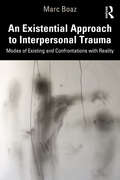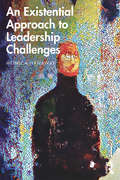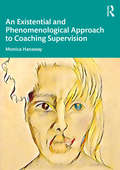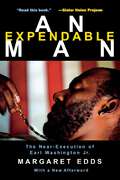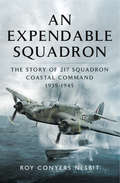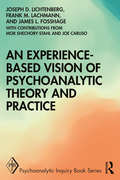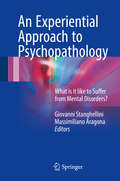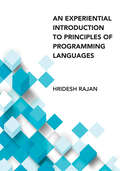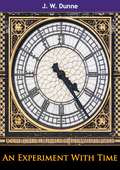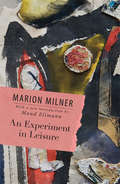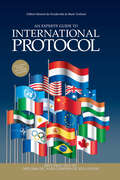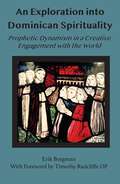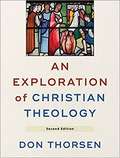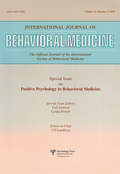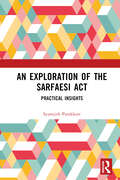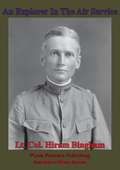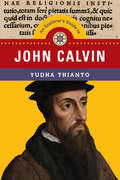- Table View
- List View
An Existential Approach to Interpersonal Trauma: Modes of Existing and Confrontations with Reality
by Marc BoazAn Existential Approach to Interpersonal Trauma provides a new existential framework for understanding the experiences of interpersonal trauma building on reflections from Marc Boaz’s own personal history, clinical insight and research. The book suggests that psychology, psychotherapy and existentialism do not recognise the significance of the existential movements that occur in traumatic confrontations with reality. By considering what people find at the limits and boundaries of human experiencing, Boaz describes the ways in which they can disillusion and re-illusion themselves, and how this becomes incorporated into their modes of existing in the world and in relation to others. In incorporating the experience of trauma into the way people live – all the existential horror, terror and liberation contained within it – Boaz invites them to embrace an expansive ethic of (re)(dis)covery. This ethic recognises the ambiguity and spectrality of interpersonal trauma, and expands the horizons of our human relationships. The book provides an important basis for professionals wanting to work existentially with interpersonal trauma and for people wanting to deepen their understanding of the trauma they have experienced.
An Existential Approach to Leadership Challenges
by Monica HanawayIn An Existential Approach to Leadership Challenges, Monica Hanaway progresses us forward from a brief, introductory understanding of existential thought to considering how this approach can positively address the practical leadership challenges our twenty-first century leaders face today. Hanaway presents a practical framework to tackle the greatest challenges in leadership, such as creating an inspiring and authentic vision, recruiting, retaining and developing staff and dealing with conflict. In Part I, she presents an overview of existential thought and what existentialism can bring to leadership, helping resolve issues of uncertainty, authenticity, relatedness, freedom and meaning making. In Part II, she explores how to work practically with an existential leadership approach, showing how existentialism can help communicate a vision, examining the vision statements of existing businesses as case studies and explaining the importance of this in recruiting, developing and retaining staff. Finally, she explores how the existential approach is beneficial in preventing, managing and dealing with conflict, defining what conflict is and introducing existentially informed conflict coaching and psychologically informed mediation practice. Combining philosophical and practical thinking, Hanaway has made existentialism an accessible resource for all leaders. This book will appeal to future leaders in practice and in training, and anyone in a leadership role. It will also be of interest to academics and students of coaching and coaching psychology, as well as to those interested in applied philosophy and psychology.
An Existential and Phenomenological Approach to Coaching Supervision
by Monica HanawayAs the methodology for coaching supervision has grown and developed in recent years, so too has the need for comprehensive engagement with the needs of supervisees. This ground-breaking and much-needed new book from Monica Hanaway presents a unique existential approach to coaching supervision. This book includes an introduction to the model, with emphasis on the philosophical focus of the existential coaching approach and concepts such as uncertainty, freedom, emotions, values and beliefs, meaning and relatedness. Hanaway offers supervisors ways of working with their supervisees on each of the key existential themes, as well as a comparison with other coaching supervision models. This book describes how a supervisor can bring an existential approach into their work, both with existential coaches and with those working in different modalities who are interested in adding to their portfolio of service. It will be of immense value to academics and students of coaching psychology.
An Expedition to Continuum Theory (Solid Mechanics and Its Applications #210)
by Wolfgang H. MüllerThis book introduces field theory as required in solid and fluid mechanics as well as in electromagnetism. It includes the necessary applied mathematical framework of tensor algebra and tensor calculus, using an inductive approach particularly suited to beginners. It is geared toward undergraduate classes in continuum theory for engineers in general, and more specifically to courses in continuum mechanics. Students will gain a sound basic understanding of the subject as well as the ability to solve engineering problems by applying the general laws of nature in terms of the balances for mass, momentum, and energy in combination with material-specific relations in terms of constitutive equations, thus learning how to use the theory in practice for themselves. This is facilitated by numerous examples and problems provided throughout the text.
An Expendable Man: The Near-Execution of Earl Washington, Jr.
by Margaret EddsHow is it possible for an innocent man to come within nine days of execution? An Expendable Man answers that question through detailed analysis of the case of Earl Washington Jr., a mentally retarded, black farm hand who was convicted of the 1983 rape and murder of a 19-year-old mother of three in Culpeper, Virginia. He spent almost 18 years in Virginia prisons—9 1/2 of them on death row—for a murder he did not commit.This book reveals the relative ease with which individuals who live at society's margins can be wrongfully convicted, and the extraordinary difficulty of correcting such a wrong once it occurs.Washington was eventually freed in February 2001 not because of the legal and judicial systems, but in spite of them. While DNA testing was central to his eventual pardon, such tests would never have occurred without an unusually talented and committed legal team and without a series of incidents that are best described as pure luck.Margaret Edds makes the chilling argument that some other “expendable men” almost certainly have been less fortunate than Washington. This, she writes, is “the secret, shameful underbelly” of America's retention of capital punishment. Such wrongful executions may not happen often, but anyone who doubts that innocent people have been executed in the United States should remember the remarkable series of events necessary to save Earl Washington Jr. from such a fate.
An Expendable Squadron: The Story of 217 Squadron, Coastal Command, 1939–1945
by Roy Conyers NesbitRoy Nesbit's highly illustrated history of Coastal Command's 217 Squadron the squadron in which he served gives a first-hand insight into the hazardous low-level missions the squadron flew against enemy shipping and ports during the Second World War. He chronicles the squadron's operations from the outbreak of war when it patrolled in Avro Ansons over the Western Approaches to the English Channel. Then came the most intense period of its wartime career when, flying Beauforts, it concentrated on minelaying and attacks on shipping along the west coast of German-occupied France. It also mounted daring raids on huge U-boat bunkers and other enemy installations. The story of these dangerous operations, in which many aircraft were lost and airmen were killed, makes up the most memorable section of the narrative. But Roy Nesbit takes the squadron's story right through to the later years of the war when, after a short and even more dangerous period flying from Malta in order to sink enemy shipping in the Mediterranean, it was based in Ceylon and was re-equipped with Beaufighters for the battle against the Japanese. In addition to telling the story of the squadron and the men who served in it, the narrative describes the conditions endured by the French people in the ports 217 attacked, and it covers the raids launched against German coastal bases after the squadron had moved to the Far East. An Expendable Squadron will be absorbing reading for anyone who has a special interest in the history of Coastal Command, in the aircraft 217 Squadron flew, and in the experience of combat flying seventy years ago.
An Experience-based Vision of Psychoanalytic Theory and Practice: Seeking, Feeling, and Relating (Psychoanalytic Inquiry Book Series)
by Joseph D. Lichtenberg Frank M. Lachmann James L FosshageAn Experience-based Vision of Psychoanalytic Theory and Practice looks at each individual as a motivated doer doing, seeking, feeling, and intending, and relates development, sense of self, and identity to changes that are brought about in analytic psychotherapy. Based on conceptualizing experience as it is lived from infancy throughout life, this book identifies three major pathways to development and applies Lichtenberg, Lachmann, and Fosshage’s experience-based vision to psychoanalytic psychotherapy. Using detailed clinical narratives and vignettes, as well as organizational studies, the book takes up the distinction between a person’s responding to a failure in achieving a goal with disappointment and seeking an alternative path, or with disillusion and a collapse in motivation. From the variety of topics covered, the reader will get a broad overview of an experience-based analytic conception of motivation begun with Lichtenberg’s seven motivational systems. This title will be of great interest to established psychoanalysts, as well as those training in psychoanalysis and clinical counselling psychology programs.
An Experiential Approach to Psychopathology: What is it like to Suffer from Mental Disorders?
by Giovanni Stanghellini Massimiliano AragonaThis book introduces the reader to a clear and consistent method for in-depth exploration of subjective psychopathological experiences with the aim of helping to restore the ability within psychiatry and clinical psychology to draw qualitative distinctions between mental symptoms that are only apparently similar, thereby promoting a more precise characterization of experiential phenotypes. A wide range of mental disorders are considered in the book, each portrayed by a distinguished clinician. Each chapter begins with the description of a paradigmatic case study in order to introduce the reader directly to the patient's lived world. The first-person perspective of the patient is the principal focus of attention. The essential, defining features of each psychopathological phenomenon and the meaning that the patient attaches to it are carefully analyzed in order to "make sense" of the patient's apparently nonsensical experiences. In the second part of each chapter, the case study is discussed within the context of relevant literature and a detailed picture of the state of the art concerning the psychopathological understanding of the phenomenon at issue is provided. An Experiential Approach to Psychopathology, and the method it proposes, may be considered the result of convergence of classic phenomenological psychopathological concepts and updated clinical insights into patients' lived experiences. It endorses three key principles: subjective phenomena are the quintessential feature of mental disorders; their qualitative study is mandatory; phenomenology has developed a rigorous method to grasp "what it is like" to be a person experiencing psychopathological phenomena. While the book is highly relevant for expert clinical phenomenologists, it is written in a way that will be readily understandable for trainees and young clinicians.
An Experiential Introduction to Principles of Programming Languages
by Hridesh RajanA textbook that uses a hands-on approach to teach principles of programming languages, with Java as the implementation language.This introductory textbook uses a hands-on approach to teach the principles of programming languages. Using Java as the implementation language, Rajan covers a range of emerging topics, including concurrency, Big Data, and event-driven programming. Students will learn to design, implement, analyze, and understand both domain-specific and general-purpose programming languages. • Develops basic concepts in languages, including means of computation, means of combination, and means of abstraction. • Examines imperative features such as references, concurrency features such as fork, and reactive features such as event handling. • Covers language features that express differing perspectives of thinking about computation, including those of logic programming and flow-based programming. • Presumes Java programming experience and understanding of object-oriented classes, inheritance, polymorphism, and static classes. • Each chapter corresponds with a working implementation of a small programming language allowing students to follow along.
An Experiment With Time
by J. W. DunneA book by the British aeronautical engineer J. W. Dunne (1875-1949) on the subjects of precognitive dreams and the nature of time. First published in March 1927, it was very widely read, and his ideas were promoted by several other authors, in particular by J. B. Priestley. He published three sequels; The Serial Universe, The New Immortality, and Nothing Dies.
An Experiment in Criticism
by C. S. LewisWhy do we read literature and how do we judge it? C. S. Lewis's classic An Experiment in Criticism springs from the conviction that literature exists for the joy of the reader and that books should be judged by the kind of reading they invite. He argues that "good reading," like moral action or religious experience, involves surrender to the work in hand and a process of entering fully into the opinions of others: "in reading great literature I become a thousand men and yet remain myself." Crucial to his notion of judging literature is a commitment to laying aside expectations and values extraneous to the work, in order to approach it with an open mind. Amid the complex welter of current critical theories, C. S. Lewis's wisdom is valuably down-to-earth, refreshing and stimulating in the questions it raises about the experience of reading.
An Experiment in Leisure
by Marion MilnerWhat is it that stops people from knowing what they want? How often do we wonder where we are going and what our world is all about? Written in 1936 as a companion piece to A Life of One’s Own, An Experiment in Leisure further charts Marion Milner’s illuminating and rewarding investigation into how we lead our lives. Instead of drawing on her daily diary, she turns to memory images – images not only from her own life but also from books, mythology, travel and religion that seem to point to a suspension of ordinary, everyday awareness. From this condition of emptiness springs an increasing imaginative appreciation both of being alive and of the world we live in. With a new introduction by Maud Ellmann, An Experiment in Leisure remains a great adventure in thinking and living and will be essential reading for all those from a literary, an artistic, a historical, an educational or a psychoanalytic/psychotherapeutic background.
An Experiment in Leisure (Routledge Classics)
by Marion Milner'Before I began this experiment I had always been haunted by the feeling that the surface of life, what everyone said about it, was quite different from the reality of life, that the important things that were happening all the time were on the whole quite different from what was said about them.' - Marion MilnerWhat is it that stops people from knowing what they want? How much of our experience is shaped by images, symbols, and early memories – and do such things help or hinder one becoming an adult? Written in 1936, An Experiment in Leisure continues Marion Milner’s unique and compelling investigation into how we lead our lives, complementing the account she began in A Life of One’s Own.Attempting to understand the gap between what she memorably describes as ‘the poverty of words and the reality of living’, she draws on memory images – in books, mythology, religious experience, travel, and even going to the theatre – that seem to point to a suspension of ordinary, everyday awareness. From this state of emptiness springs an increasing imaginative appreciation of being alive and, as Milner concludes, of being a woman.With a new Foreword by Akshi Singh, An Experiment in Leisure remains a striking and captivating adventure in thinking and living with uncertainty, whose insights remain fresh and relevant today.
An Experts' Guide to International Protocol: Best Practice in Diplomatic and Corporate Relations
by Gilbert Monod de Froideville Mark VerheulAlthough modern life grows increasingly casual, in many sectors, protocol still reigns supreme. An Expert's Guide to International Protocol offers an overview of its associated practices, including those found within the context of diplomatic relations and the business world. Focusing on a wide range of countries and cultures, the book covers topics like precedence, seating arrangements, flags, ceremonies, invitations, dress codes, gifts and honours, and the roles of the protocol officer, guest and host. Throughout, influential diplomatic, business, and cultural figures share their own experiences with protocols around the world, also throughout the COVID-19 pandemic.
An Explanation of Constrained Optimization for Economists
by Peter MorganIn a constrained optimization problem, the decisionmaker wants to select the "optimal" choice - the one most valuable to him or her - that also meets all of the constraints imposed by the problem. Such problems are at the heart of modern economics, where the typical behavioral postulate is that a decisionmaker behaves "rationally"; that is, chooses optimally from a set of constrained choices.Most books on constrained optimization are technical and full of jargon that makes it hard for the inexperienced reader to gain a holistic understanding of the topic. Peter B. Morgan's Explanation of Constrained Optimization for Economists solves this problem by emphasizing explanations, both written and visual, of the manner in which many constrained optimization problems can be solved. Suitable as a textbook or a reference for advanced undergraduate and graduate students familiar with the basics of one-variable calculus and linear algebra, this book is an accessible, user-friendly guide to this key concept.
An Explanation of the Thirty-nine Articles, With an Epistle Dedicatory to the Rev. E. B. Pusey
by Alexander Penrose Bishop of Brechi ForbesThis work has been selected by scholars as being culturally important, and is part of the knowledge base of civilization as we know it. This work was reproduced from the original artifact, and remains as true to the original work as possible. Therefore, you will see the original copyright references, library stamps (as most of these works have been housed in our most important libraries around the world), and other notations in the work.
An Exploration into Dominican Spirituality: Prophetic Dynamism in a Creative Engagement with the World (The Southern African Dominican Series)
by Erik Borgman'My aim in this book is to show clearly that the ... Dominican tradition ... is capable of shedding light on the questions of men and women today and suggesting a way of dealing with them. These questions are ultimately a variant of the one central question of human existence, bound up with a particular time, place and person: the question of a good and meaningful life ... my starting point is the basic conviction that a religious and dedicated life cannot be lived anywhere else than in the midst of our turbulent culture, which constantly makes us uncertain ... this book is deliberately written from the perspective of someone who in ecclesiastical jargon is called a "lay person".' From the Introduction by Erik Borgman 'This book is a highly attractive and stimulating exposition of Dominican spirituality by Erik Borgman, a Dutch Lay Dominican. The central intuition of the book is that Dominican spirituality is founded on the encounter of God in all of human experience. Dominic's experience in the early thirteenth century was born in opposition to Catharism, which maintained that God was remote from us and that there was a fundamental opposition between the divine and this material world. But for Dominic it is here, in our lives, with all their creativity and goodness, their mess and confusion, that God is to be found. Our mission as preachers pushes us "to enter the unrest of the street and the inn, politics and journalism, welfare, teaching and science, in the belief that the holy, the traces of the Holy One, are to be found there". Even in the most difficult situations, when all is dark, God is waiting to be discovered. "If Dominican spirituality has a core, then it would be this insight into the unexpected and unheard-of nearness of God'. This is the good news that the Order of Preachers was founded to preach and the source of the happiness of the preacher."' From the Foreword by Timothy Radcliffe OP
An Exploration of Christian Theology
by Don ThorsenThis introduction to Christian theology explores the whole Christian tradition in a simple and straightforward way. Leading Wesleyan theologian Don Thorsen surveys the theological views represented within historic Christianity and discusses the variety of positions held without favoring one over another. The book includes helpful end-of-chapter questions for further reflection and discussion, a convenient glossary of theological terms, and sidebars. The second edition is marked by a thorough updating of the text and the addition of two new chapters on apologetics and the future of the unevangelized.
An Exploration of Trance Mediumship
by Chris RatterWhen psychic surgeon Chris Ratter was starting out on his own path of unfolding trance mediumship, he found there was very little information available to clarify certain points or answer questions he had. His desire to ensure others did not feel the same isolation and confusion became his main motivation for writing An Exploration of Trance Mediumship. Chris takes the reader on a touching quest to find greater understanding of the bridge between our world and the world of spirit, explaining key aspects of trance mediumship as well as introducing the reader to his spirit team and providing insight as to how he came to know his individual guides. All mediumship is healing, and an accurate, perceptive verbal communication from a loved one in spirit has the power to mend a metaphorical broken heart. When it comes to the physical body, however, Chris's psychic surgery, which goes hand-in-hand with his trance mediumship, has the power to heal across the spectrum of psychological and physiological conditions.
An Exploration of the Health Benefits of Factors That Help Us to Thrive: A Special Issue of the International Journal of Behavioral Medicine
by Gail Ironson Lynda PowellFirst published in 2005. Routledge is an imprint of Taylor & Francis, an informa company.
An Exploration of the Private Sector Response to Changes in Government Saving Across OECD Countries
by Alun ThomasA report from the International Monetary Fund.
An Exploration of the SARFAESI Act: Practical Insights
by Syamjith ParakkottThis book looks at the constitutional and regulatory frameworks of loan and debt recovery laws and legislations. It explores different aspects of the Securitisation and Reconstruction of Financial Assets and Enforcement of Security Interest (SARFAESI) Act, 2002, along with the issues and challenges in enforcing the Act in India.The book explores the evolution of debt recovery laws in India by analysing various past cases and legislations relating to the recovery of dues by banks and financial institutions. Taking the rights of both banks and borrowers into consideration, it provides a description of the relevant provisions of the SARFAESI Act and its implications. The author analyses relevant case laws and practical experiences to highlight the positives and the issues of the SARFAESI Act that have strengthened the creditor’s rights in India. The book also looks at the consolidation of insolvency and bankruptcy laws in India that have contributed to the process of debt recovery while protecting customers.Lucid and comprehensive, this volume will be an indispensable resource for students and researchers of law, business and company law, monetary economics, macroeconomics, Asian law, and comparative law. It will also be useful for teaching faculty, legal practioners and bankers.
An Explorer In The Air Service [Illustrated Edition]
by Lt. Colonel Hiram BinghamHiram Bingham was a visionary, widely acknowledged in his own time for his talents as an academic, explorer and United States senator. Hailing from Hawaii, where his family before and since have provided much public service, and an expert in South American history, he became world famous for his 'discovery' of the Quecha capital, Machu Picchu.His amazing breadth of service also encompassed service in the national guard, and he became an aviator and organized the United States Schools of Military Aeronautics at eight universities to provide ground school training for aviation cadets. Head of the famed Third Aviation Instruction Center at Issoudun in France, he was responsible for the training of pilots from initial flying to advanced pursuit training. Accompanied by many notes and diagrams of the tactics, schemes and manoeuvres (many illustrated) used in the air war over France, these memoirs from his days as head of the Training school make for fascinating reading.Author -- Lt. Col. Bingham, Hiram, 1875-1956.Text taken, whole and complete, from the edition published in New Haven, Yale university press; [etc., etc.] 1920.Original Page Count - xiv, 260 pages.Illustrations -- numerous illustrations and maps.
An Explorer's Guide to John Calvin (Explorer's Guides Series)
by Yudha ThiantoCreation is the theater of God's glory. Scripture is like a pair of glasses that clarifies our vision of God. Justification is the hinge on which religion turns.Institutes of the Christian ReligionInstitutesInstitutesBooks in the Explorer's Guide series are accessible guidebooks for those studying the great Christian texts and theologians from church history, helping readers explore the context in which these texts were written and navigate the rich yet complex terrain of Christian theology.
An Explorer's Guide to Karl Barth (Explorer's Guides)
by David GuretzkiChurch Dogmaticsfrequently asked questionsa glossary of key concepts and personsa tour guide to Barth's early writingstips on how to write a paper on BarthChurch DogmaticsAn Explorer's Guide to Karl Barth
